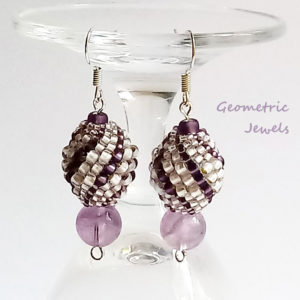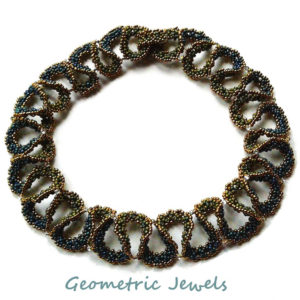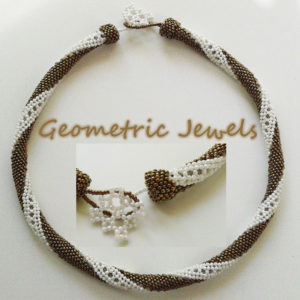Gerlinde Lenz – Bead Artist, Interviewed
I’m thrilled to be able to bring you this lovely interview with beading designer, Gerlinde Lenz. If this is a name you’re not familiar with, you might know some of the stitches she has created. Ever heard of Diamond Weave? How about Peyote with a Twist? Well, Gerlinde Lenz is the brains behind both of those.
She lives in Germany and has been beading in one way or another for most of her life. Driven by a passion for exploration and discovery, I hope you will enjoy reading her story…
Gerlinde, welcome! Can you start by telling us how you got started in beading?
It took a few starts, really. First acquaintance as a kid, when I made a coaster in colours and shapes of my grandmother’s coat of arms from big beads using Peyote.
As a teenager, I played a lot with silver wire and beads.
Decades later, when playing with silver beads to fulfil an old dream about a silver ball necklace, I set myself the challenge to make a dodecahedron from beads. And after a while, I succeeded. The other Platonic solids and many of their variations followed, and that time is when my trading name came up.
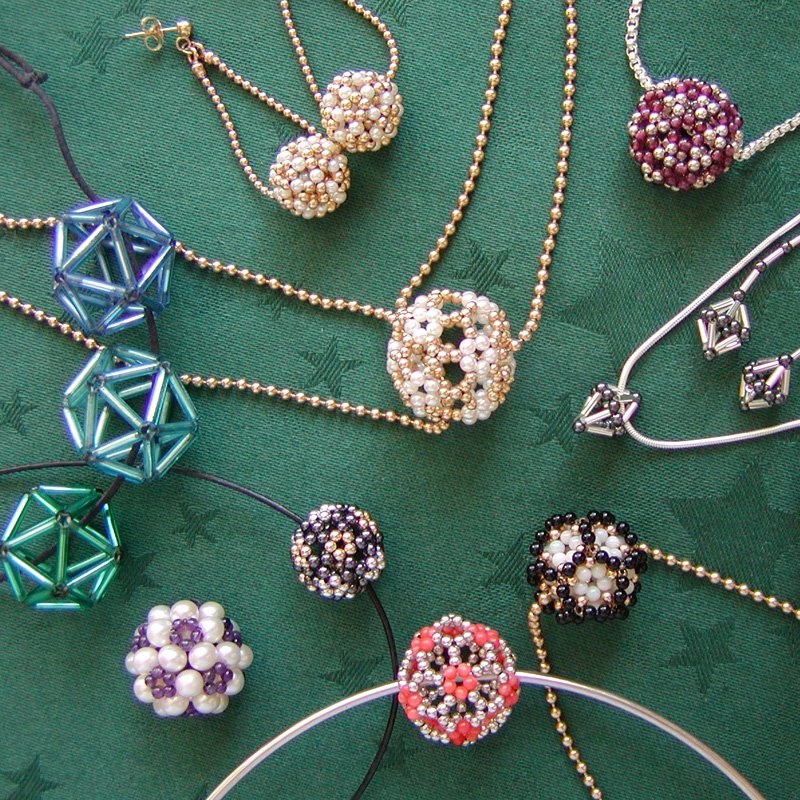
I did not know of quality Japanese beads then, and so the only beads even enough for geometric work were precious metals and stones. The holes in those stones are tiny, forcing me to find thread paths with no more than two passes through a bead.
In 2004, finally, someone challenged me to make a very plain bridal bracelet. That is when I came up with Diamond Weave, which I found to be enormously versatile.
I could not come up with enough attractive designs for all the important variations. So, I was delighted to accept Cath Thomas’ offer to help me write the book about it. It was published in 2015.
Yes, we’ll come back to talk about Diamond weave later. So, did you have any formal training during this time?
I took very few classes with masters like Kerrie Slade, Elena Markovski, Anja Schlotmann and Huib Peterson. Occasionally I learned from books, but mostly I learned from experiments.
What are your favourite techniques?
Diamond weave is still my favourite. But I’ve been exploring the realm of diagonal Peyote, especially ‘Peyote with a twist’ since I found this method of creating tubes which look like bead crochet tubes, in 2016.
Again, we’ll talk more about PWAT in a minute. But first, Gerlinde, how would you describe your style?
Very plain. I use cylinder beads and seed beads, and rarely pearls, firepolished beads, bicones or other shapes in my work. So, I even managed to make a Cellini spirals with only one size of beads!
I tend to stick to geometric shapes. Even the flowers I love are usually very geometric.
Who, or what, inspires your work?
Usually, it’s technical questions. Can I create a self-supporting dodecahedron? Can I make a weave with the beads sitting in a rectangular grid? (I didn’t know herringbone back then.)
Can I create a rope looking like crocheted, without having to crochet? How can this rope be varied? Can I bezel with all kinds of weaves, including Diamond Weave and diagonal Peyote to allow maximal stone visibility?
So, my beading space is chaos! Heaps of failed experiments which have not been cleaned up!
Do you have a favourite piece (or pieces) of work, Gerlinde?
Of course the first samples of new techniques are special. And then there are pieces which friends have asked for instructions for. And some pieces where the challenge of getting the neck curvature right has been met well. For ease of wearing, I prefer bangles over bracelets.
Where can people find your work in print?
Most importantly, Cath Thomas and I self published our book ‘Diamond Weave’, supported by Amazon and its publisher.
Other than that, I have had articles published in Bead and Button Magazine, Beadwork Magazine and Perlen-Poesie. I also have two photos in ‘Showcase 500’. That is a collection of photos by Ray Hemachandra, published by Lark Jewelry and Beading in 2012.
Early photos are on display on my flickr page, and later ones on my facebook page.
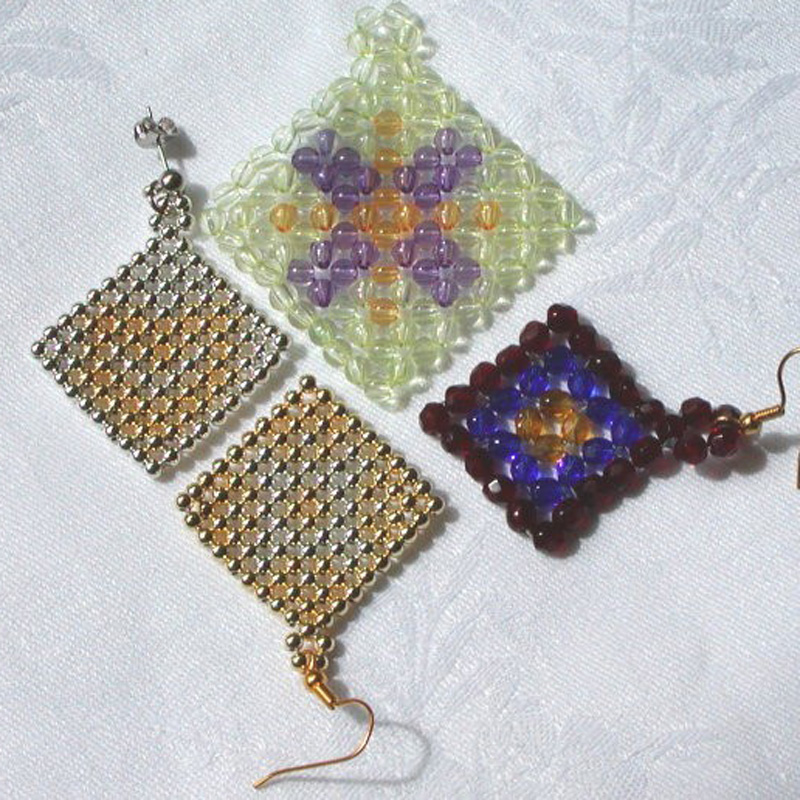
Do you have any advice for people wanting to create or sell their own designs?
No, I’m not much of a designer myself. I believe that good designing is a rare gift. So, until something really nice results from the experiments, I recommend to be content with experimenting and learning from all the failures!
Make sure you don’t HAVE to sell your work. You are under much less pressure to adjust to other people’s taste that way.
That’s good advice! Now, if we can, let’s come back to talk more about Diamond Weave and Peyote With A Twist
Both were developed because there were things I could not do. In the case of DW, I wanted a bracelet like the design you saw above (excerpt from DW book), but didn’t know, how. I’m sure my experience with self-supporting spheres helped me find the thread path.
The structure lends itself to grid-based patterns like cross stitch, but also to a lot of different expansions by extra beads. Throw in tube closure, corners, internal increases and decreases and you have a Swiss army knife of a tool! You can tell I love it, can’t you?
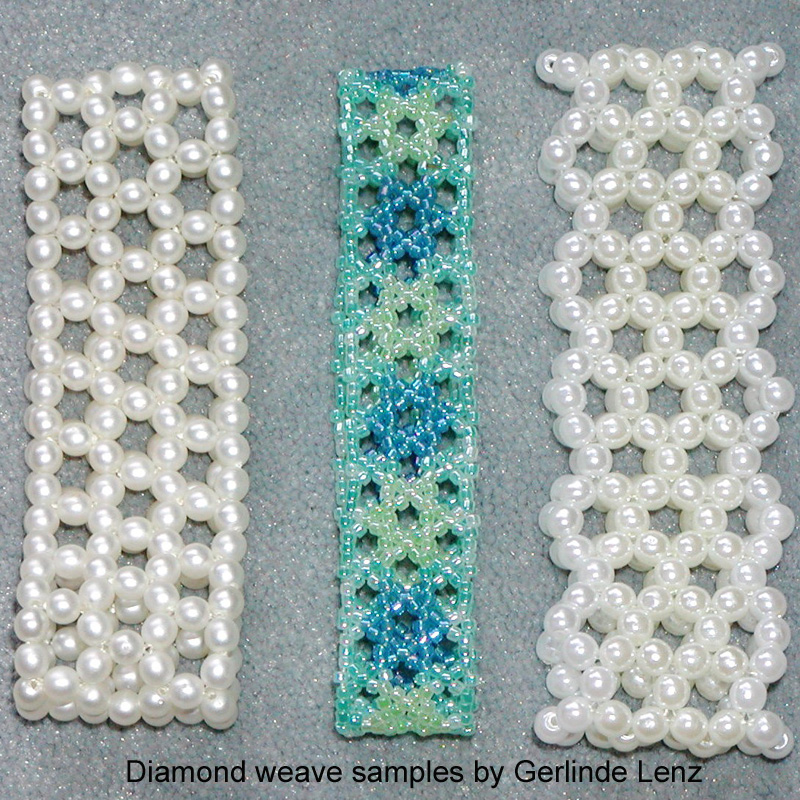
PWAT
Peyote with a twist was the result of frustration. After years of failed attempts, I had finally learned how to bead crochet. But after about an inch of it my hands hurt so badly, and it had taken so long that I gave up. That was not for me. But – I had this pretty pattern, and all the beads for it – maybe there was another option? The beads in the crocheted tubes sit in a Peyote grid, but obliquely to the axis of the tube – could this be mimicked in Peyote? Yes, it can!
I had often read about others having difficulty with bead crochet too. So, I decided to publish the instructions in a facebook group https://www.facebook.com/groups/128513761079892/.
I was very lucky to find kind and knowledgeable moderators, and with their help, the group was extremely successful. Thousands joined, and contributed their patterns, discoveries and tips.
In the meantime, there are about a dozen videos on the topic. Amazing variations on the concept arose – for example four different ways to vary bead size in Cellini style, how to work a V shape, and how to combine Peyote with other stitches.
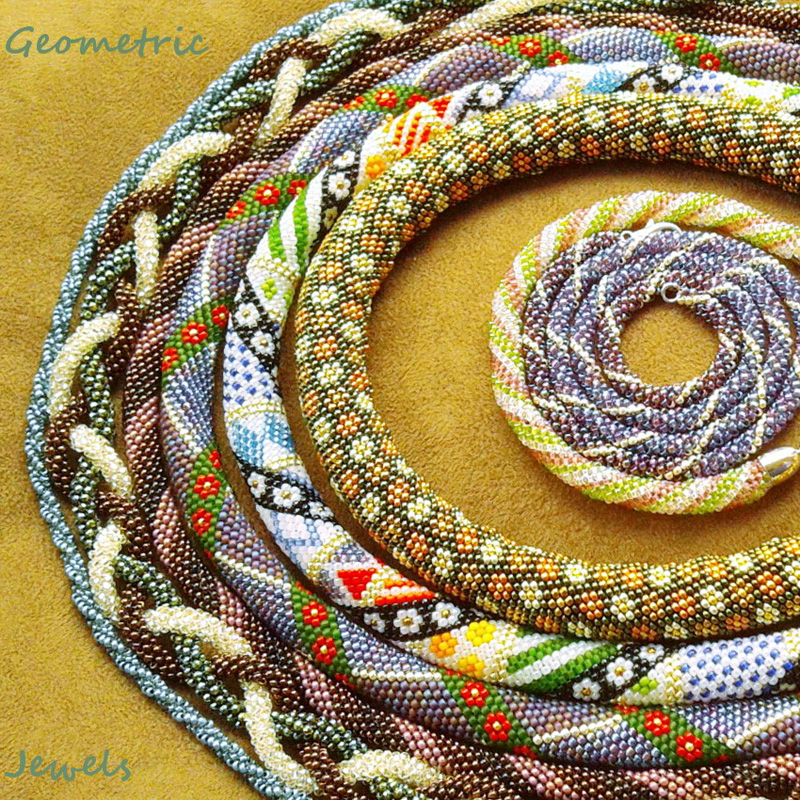
While at first it only was a method which would allow the realisation of bead crochet patterns without having to bead crochet, it soon turned out that those very strict limitations don’t apply. Little tricks allow patterns to be more geometrical than crocheted patterns. Many free patterns have been translated and possibly adapted to Peytwist. Many original patterns have been donated to be used by the group, and dozens of new patterns are available for sale.
I guess I’m very lucky to be living in internet times!
Contact details for Gerlinde Lenz
You can find Gerlinde Lenz work on her Facebook page: https://www.facebook.com/geometricjewels She trades under the name of ‘Geometric Jewels’.
This link will also take you to her Flickr page where you will find photos of her older work.

Next steps
If you’ve enjoyed this interview with Gerlinde Lenz, I encourage you to dip into some of the other interviews I’ve done with leading beading designers. You can find them all here.
You might also like to check out the Techniques section on this website if you’re interested in learning Diamond Weave or PWAT.


